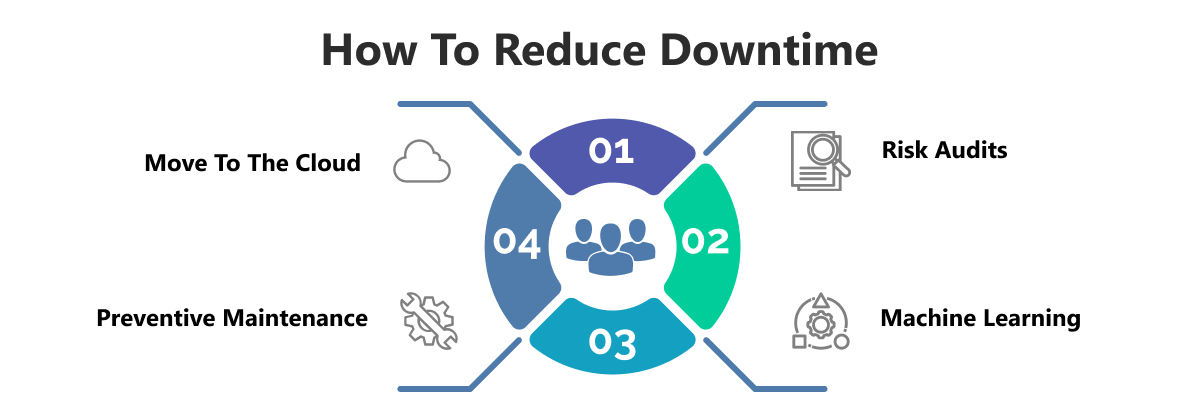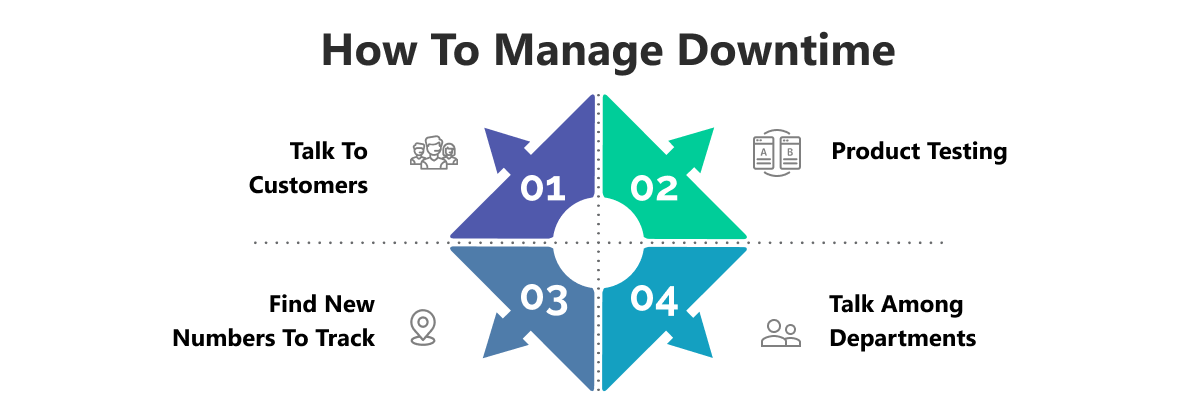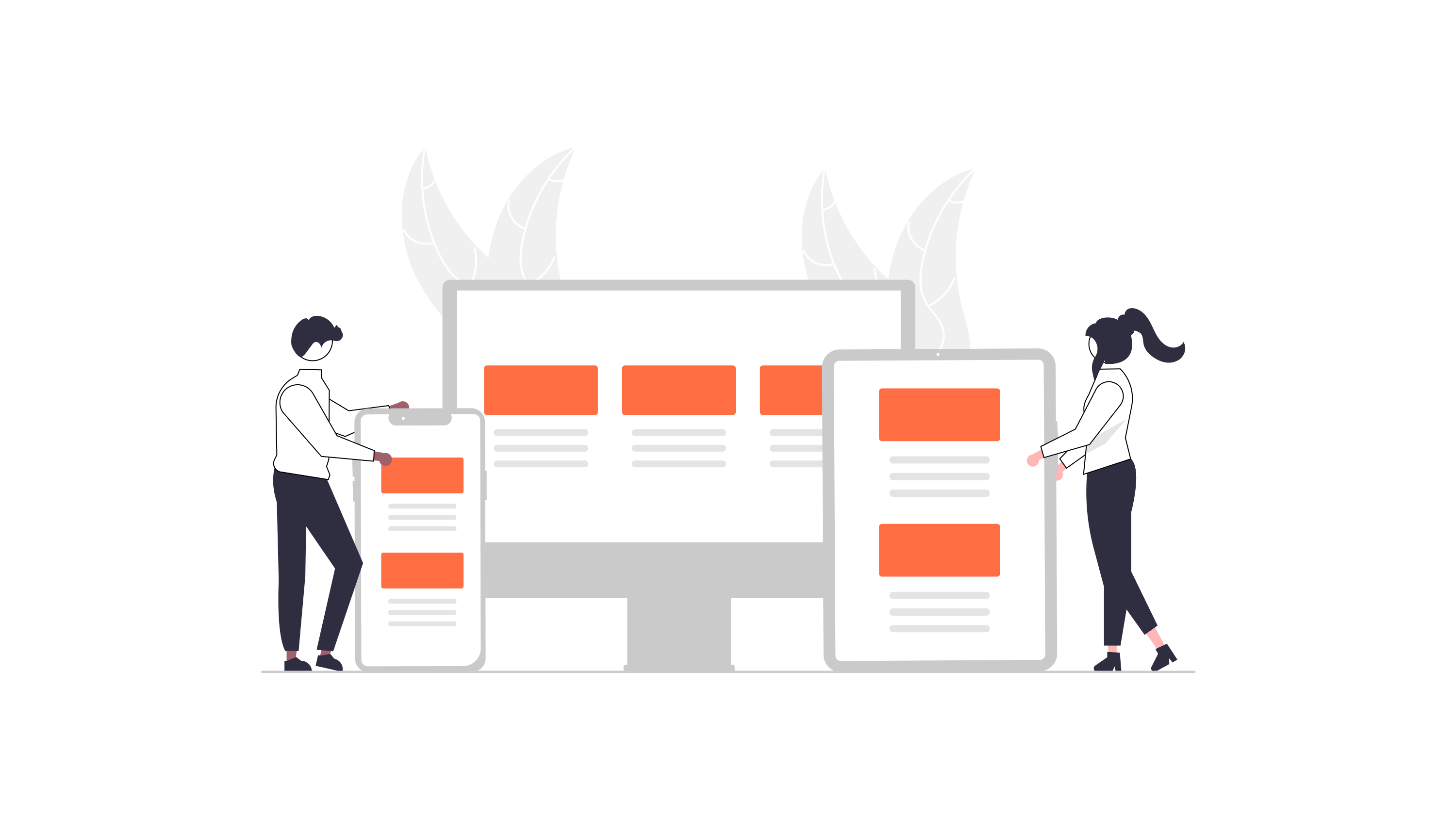No matter how planned your startup is, there are going to be scenarios where things could lead to unavoidable downtime. While this can be reduced to an extent, there needs to be a proactive system already in place to ensure that your teams and processes aren’t affected much during unplanned downtimes.
In this blog, we’ll discuss how you can reduce downtime and leverage work during inevitable downtimes. We’ll also see how downtimes aren’t as bad as it seems if you have a proper framework in place.
For product owners and managers, having downtime can feel like lost work. but there is still a long list of intuitive things they could do to better their understanding of the product they’re working on.
Key Takeaways
- Production downtimes, both planned and unplanned, can be complemented by a series of activities to improve the productivity of teams.
- With more time in hand to explore more about the product, product managers and business owners can get insights that far outweigh their initial understanding and develop training models or feedback mechanisms to better their offering.
- There are frameworks to reduce downtimes and there are methods to optimise downtime. Both must be learned to create a holistic downtime management framework.
How to reduce downtime
No matter how big or small your team size/process is, there can be apparent delays that could spring up along the way. In this section, we’ll see how to build frameworks and proactive measures to reduce overall downtime and improve efficiency.
Unplanned downtime can cause unforeseen delays in deployment, which is never a good thing for a company. The uncertainty it brings can create a level of confusion that could eventually evolve into a panic-stricken situation where teams find it difficult to work efficiently.

So everything that comes under unplanned downtime reduction has a high level of impact across the organization.
Move to the cloud
Much of machine shutdowns or malfunctions that could lead to halts can be solved by migrating your database and applications to the cloud. You can choose dedicated, public, or shared servers to store data and ensure your application runs hassle-free based on budget.
Moving to the cloud is also a financial decision that requires proper consideration of the kind of databases you build and your data security needs. One great advantage here is that cloud-enabled platforms provide 24/7 support which reduces the need for shift-based work.
Transcending from an on-premise hardware-based data management solution to the cloud can instantly reduce initial costs to set up and floor space and maintenance that comes with it. You also get the option to automate maintenance and get timely alerts to ensure your cloud database is always up to date.
Preventive maintenance
People working on products understand that there’s always scope for improvement and there will be eventual bugs or crashes during development. With scheduled maintenance through patches and updates, teams can minimize the chances of past errors and optimize their offering.
This is especially true while ensuring data security for products/services. As there is an ever-increasing influx of cyber-security threats across every industry, you need continuous support and upgrades to maintain a safe and secure environment for all your applications.
Setting up scheduled maintenance also helps to get all the pent-up issues to be solved before they get out of hand. Often, these maintenance cycles uncover opportunities to better or even pivot to more advantageous product ideas to pursue. With enough flexibility, preventive maintenance can be implemented whenever there is a bug in the system.
Risk audits
Conducting a risk analysis is a proactive way to ensure the peak health of your systems and frameworks. Understanding that every hardware or software version you build has a lifespan before it starts to deteriorate can help you plan new ways for your product’s longevity.
Just like preventive maintenance, planning an upgrade, patch, or process analysis could help you figure out ways to minimise failures in the future.
Understanding risk can also help you decide on the pace of operation too. This is especially useful from an IoT-enabled industrial automation use case where adjusting machine operation can greatly increase the longevity of the production line.
Every new feature, process. Or server improvement can bring with it a possibility for risk too. Understanding that custom frameworks might require monitoring and forecasting of issues is the best way to anticipate bugs and solve them proactively.
Machine learning
Deploying machine learning models to IoT systems within industrial setups can significantly reduce downtimes. By employing AI algorithms to input machine data, AI models can effectively find ways to optimise operations.
For example, a machine that can change its production speed under varying conditions can be automatically set to optimum productivity by employing machine learning models in the IoT system controlling the machine. This ensures a longer lifespan for the machines while ensuring that production is never halted at any time.
Using advanced AI to optimise processes helps you focus on new challenges rather than just maintaining current production figures. Repetitive processes, when optimised, can improve process efficiency and reduce downtimes naturally.
While on downtime

There are ways to reduce downtime, but trying to eliminate them entirely is not exactly a great idea to pursue. Downtimes can actually help bring up new areas of improvement and also help you better understand the process altogether.
With much of every industry in constant competition and innovation, it can come as a surprise how well you can optimize downtime to perfect your product. Understanding user needs, finding better ways to market, and even finding new ways of cooperation among departments can all be possible outcomes of unplanned downtime.
Talk to customers
The best thing you can do during an unplanned downtime is to talk to your customers. Often, as you build new features to products/services, there are chances that you overlook existing customer difficulties for a better version of your offering.
Asking users about their experience so far and the things they might want to see improved can get you a better understanding of market conditions too. In an ever-changing industry, the businesses that stay closest to their users will remain relevant for longer.
Re-iterating process flows and aligning them with user actions is something that can naturally happen during downtime, both planned and unplanned.
Find new numbers to track
You’ll constantly find new metrics to track as your business grows with people and customers. Initial frameworks that were used to manage resources can quickly get outdated with scale as well. It’s therefore important to review existing metrics and figure out if they are still relevant for your business.
Obsolete data and processes are the first things you can investigate during planned downtimes. As it is difficult to bring changes to workflow midway through the production process, downtimes can effectively become starting points for better operation.
Here’s where you can prioritise your assets and find weak points in the system. As downtimes often create bottlenecks for other departments to function well, it’s better to check the features or equipment that are the most vulnerable to a bug or shutdown.
Product testing
Production downtimes also open up opportunities to find areas of improvement from a testing standpoint. With downtimes often occurring due to errors unaccounted for, it’s better to test different use cases and ensure that the chances of errors are progressively less.
For a fully operational product, combining in-house testing and user testing can significantly alter the way you view the product. As products evolve with more features and changed user journeys, it’s important to track down any shortcomings that may have missed your initial screening.
Unplanned downtimes are always stressful, but there is so much to the product that you could understand from such events. Downtimes reveal some of the bottlenecks to startup operations and help them reiterate their priorities while scaling their offerings.
Talk among departments
Production downtimes reveal bottlenecks in other departments too, which can adversely affect production. So it’s best to have discussions across departments and teams on how to handle such production delays in the future better.
If the downtime is caused by another team, now is the time to understand the process flow better and anticipate any overloads that your team can cause others. While most productive startups have an agile framework to handle multiple tasks without hassle, it’s always helpful to communicate among teams about the chances for downtime and any safeguards against it.
Further steps
Downtimes are rarely an easy event and often require a bit more thoughtful action to avoid future downtimes of the same nature.
While they are sometimes inevitable, downtimes can sometimes give disruptive opportunities to capitalise on. Storage, communication, and even logistics have significantly benefited from downtime, optimising and gaining into unexplored markets.
Phrasing downtime as opportunities is fairly unlikely in a business situation, but keep in mind the opportunities that can unveil in these unconventional business situations.
We’ve helped companies bleeding with unpredictable downtimes make a complete turnaround with the right technology adoption. Especially on mobile development roadblocks and projects that involve cutting-edge AI to be developed within tight deadlines.
To learn more about how we build solutions for startups and scale-ups, read about our services or talk to us today!




